advertisement
Microsoft Surface Go 2 review: A Gorgeous, Pricey Tablet with a Decent CPU
The Surface Go 2 is a tablet that doesn’t fit easily into traditional niches. As the entry-level product in Microsoft’s…
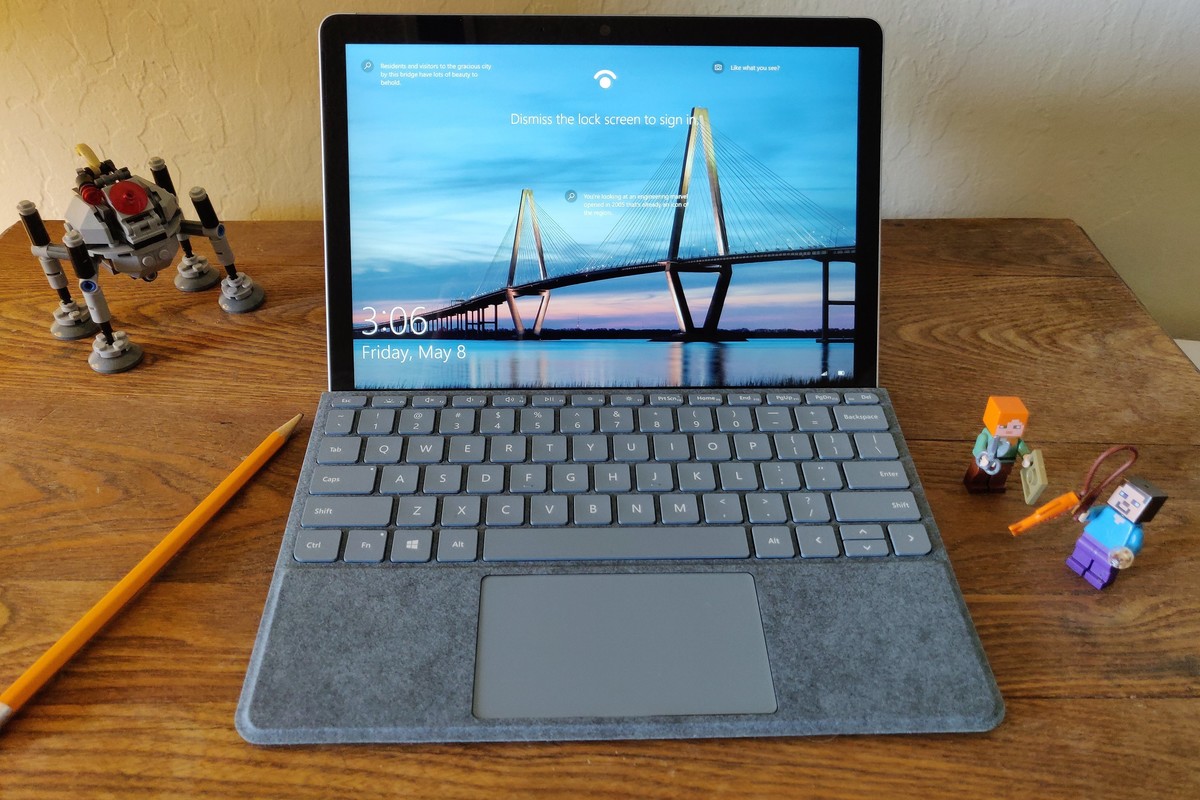
The Surface Go 2 is a tablet that doesn’t fit easily into traditional niches. As the entry-level product in Microsoft’s Surface line, it’s still somewhat expensive, but it offers a beautiful screen and one of the best camera sets you’ll find anywhere. Performance is another matter: At its best, with an 8th-gen Intel Core m3 under the hood, the Surface Go 2 is comparable to the Surface Pro 3 from 2014. That’s fine if you stick with everyday productivity, but don’t expect much more.
What’s a competent, though pricey, ultramobile tablet to do? The Surface Go 2 could be an ideal secondary device for business travelers, who will appreciate its fanless design, LTE options, and its ability to squeeze onto a tray table. The kid-sized display and keyboard may make it a good option for students, especially given the app protections afforded by Windows 10 S. It may not compete with an iPad, but it could be your family’s Netflix tablet. We just wouldn’t recommend the $400 lowest-end version, as it has skimpy memory and storage.
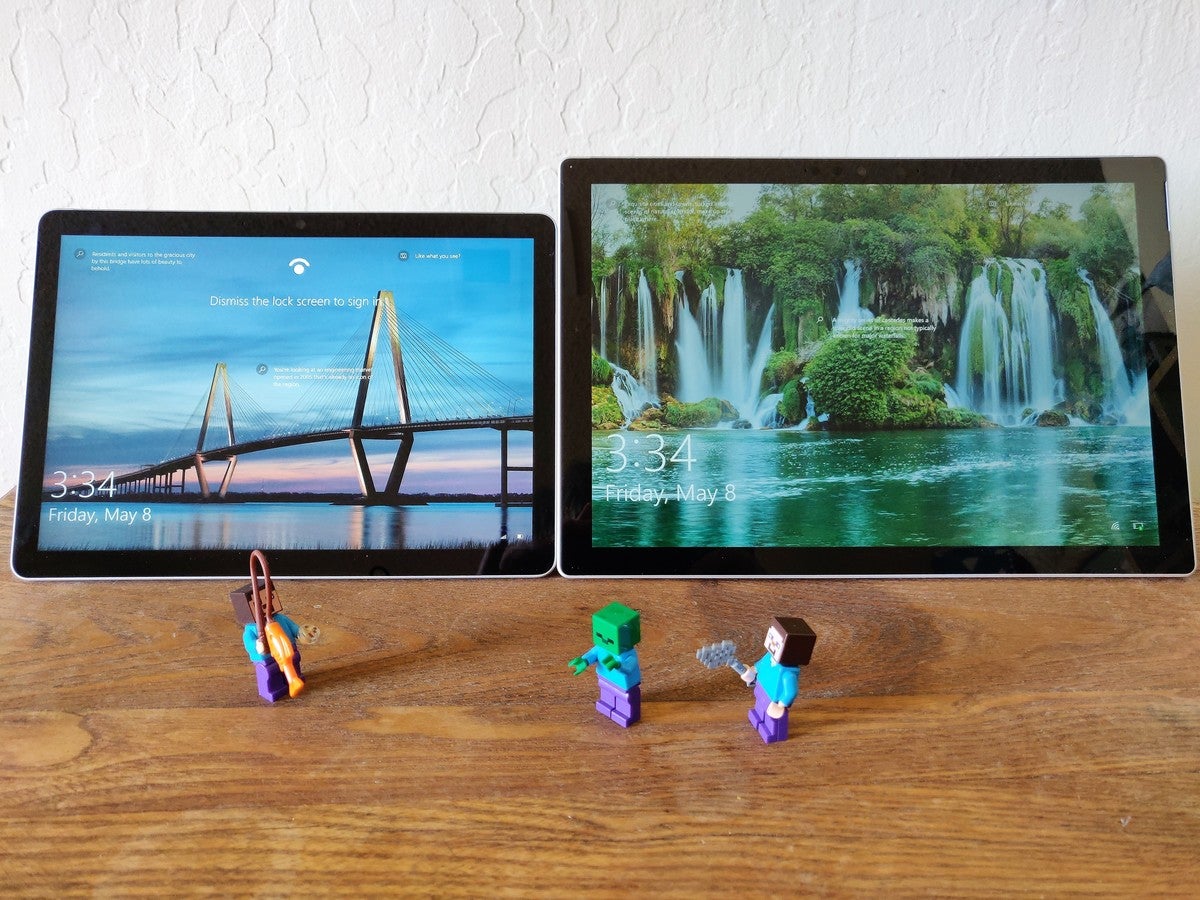 MARK HACHMAN / IDG
MARK HACHMAN / IDGSurface Go 2 prices, Specs and Features
Like many of its other Surface tablets, Microsoft will sell the Surface Go 2 in both consumer and commercial editions. The consumer version ships with Windows 10 Home in S Mode, from which you may switch to Windows 10 Home if you wish. Microsoft sells the Surface Go 2 Signature Type Cover and Surface Pen separately, though the former, at least, is essential.
advertisement
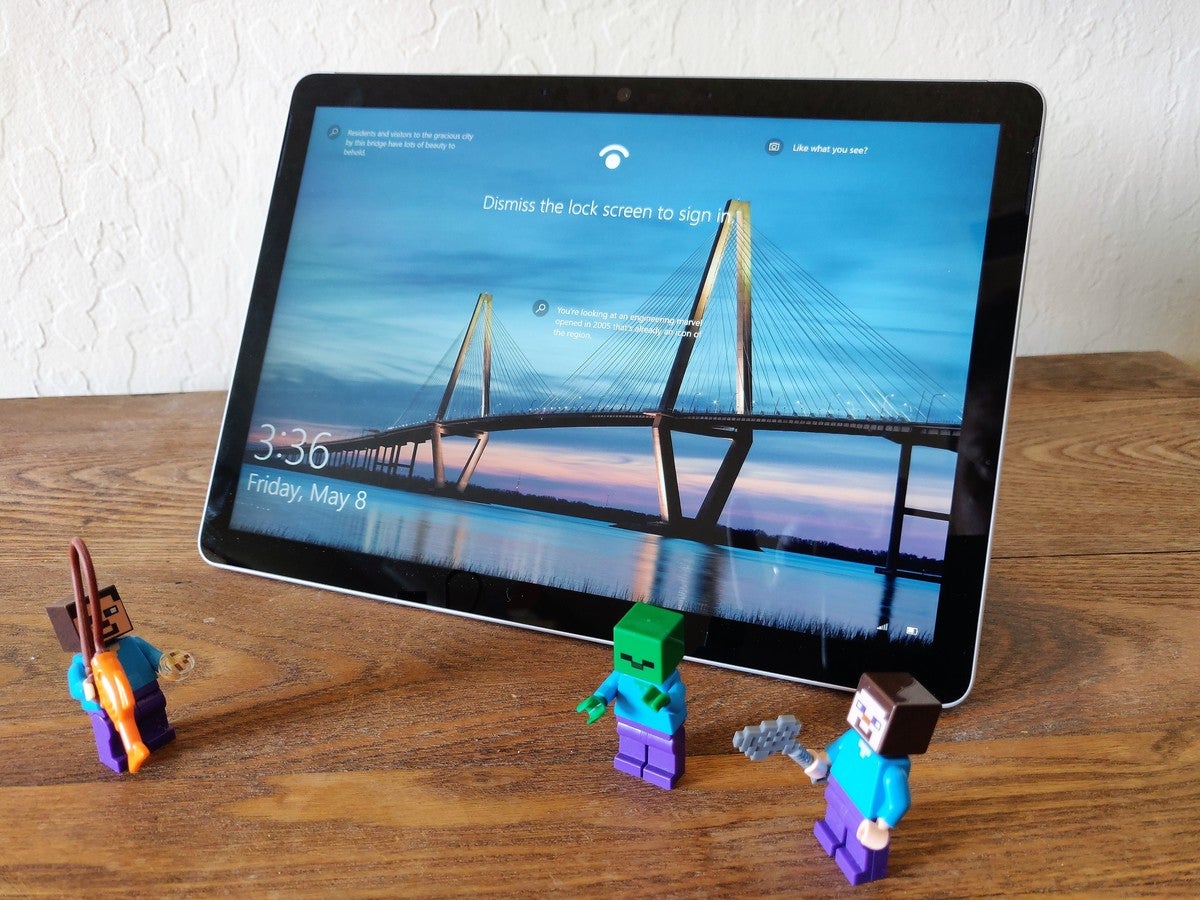 MARK HACHMAN / IDG
MARK HACHMAN / IDGAs we reviewed one of the consumer versions, we’ll reiterate that pricing below. For the full list of prices for all models, see our original Surface Go 2 news story.
Surface Go 2 consumer prices
- Pentium Gold 4425Y, 4GB RAM, 64GB eMMC: $400
- Pentium Gold 4425Y, 8GB RAM, 128GB SSD: $550
- Core m3-8100Y, 8GB RAM, 128GB SSD: $630
- Core m3-8100Y, 8GB RAM, 128GB SSD, LTE: $730 (our test unit)
While the $400 price of the entry-level model is tempting, resist. No one should be using a tablet with a measly 4GB of RAM and 64GB of eMMC storage. The minimum configuration should be the $550 (8GB RAM/128GB SSD) model.
Surface Go 2 specifications
- Display: 10.5-inch (1920×1280, 220 ppi), 3:2 aspect ratio PixelSense display with 10-point touch; Corning Gorilla Glass 3
- Processor: Intel Pentium Gold 4425Y or Core m3-8100Y (Amber Lake Y)
- Graphics: UHD 615
- Memory: 4GB or 8GB RAM
- Storage: 64GB eMMC or 128GB SSD
- Ports: USB-C, Surface Connect, microSD, 3.5mm jack
- Camera: 5MP (1080p) user-facing, Windows Hello; 8MP (1080p) rear-facing, with autofocus
- Battery: 26.8Wh (reported by Windows)
- Wireless: 802.11 ax (Wi-Fi 6); Qualcomm LTE Advanced X16 modem
- Operating system: Windows 10 Home in S mode (consumer); Windows 10 Pro (commercial channels)
- Dimensions (inches): 9.65 x 6.9 x 0.33 inches (8.3mm)
- Weights (per Microsoft): 1.2 pounds with Wi-Fi, 1.22 with LTE (not counting Type Cover)
- Color: Silver
Surface Go 2: Solid build, brilliant display
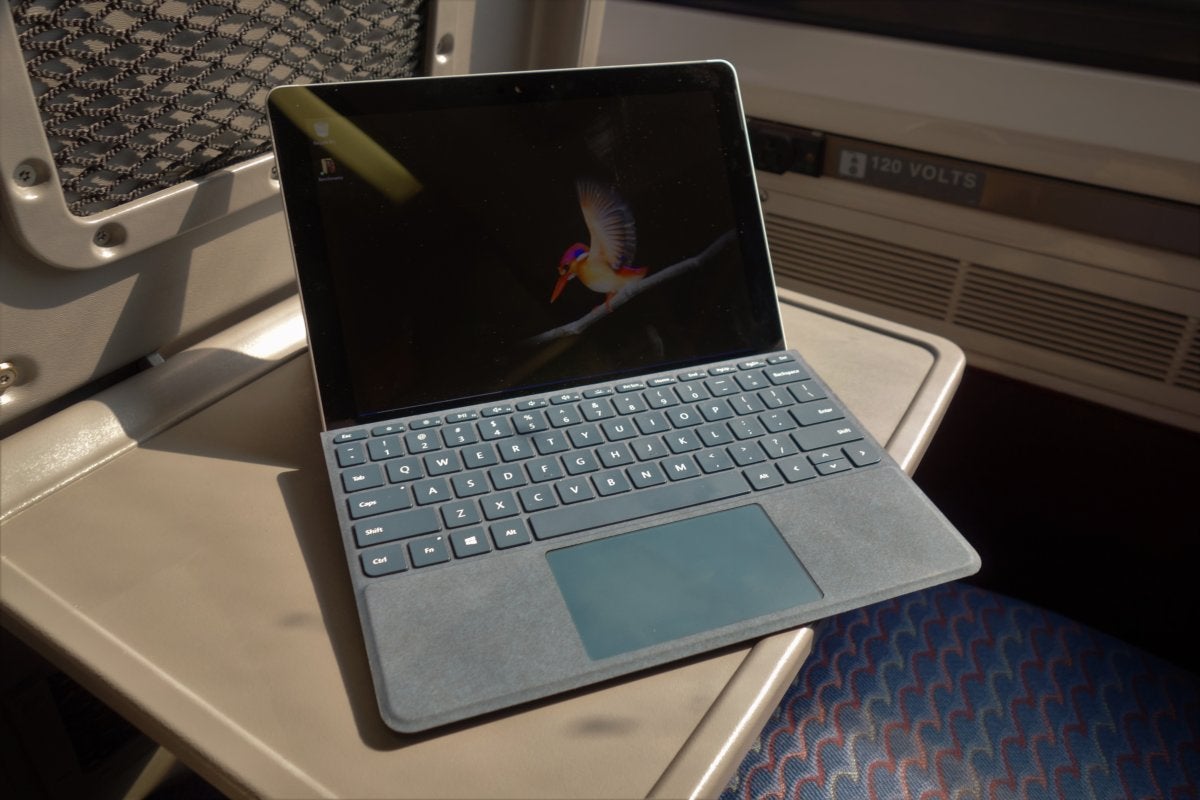 MARK HACHMAN / IDG
MARK HACHMAN / IDGFor this second-gen Surface Go, Microsoft maintains the magnesium chassis and fanless design of its predecessor. A small section on the rear of the tablet warmed as we ran various tests, but never approached hot.
advertisement
You need a bit of bezel for gripping a tablet, but Microsoft slimmed them down enough to squeeze in a larger 10.5-inch PixelSense display and more pixels (1920×1280, 220 ppi). Save for the additional pixels, the display remains virtually unchanged from the prior generation’s. The colors are vivid and accurate, though the Go 2 lacks the color profile options of the Surface Book 2. The display brightness is a high 493 nits. That’s substantially more than what we consider necessary for everyday work, though not enough to work outside during the noon sun.
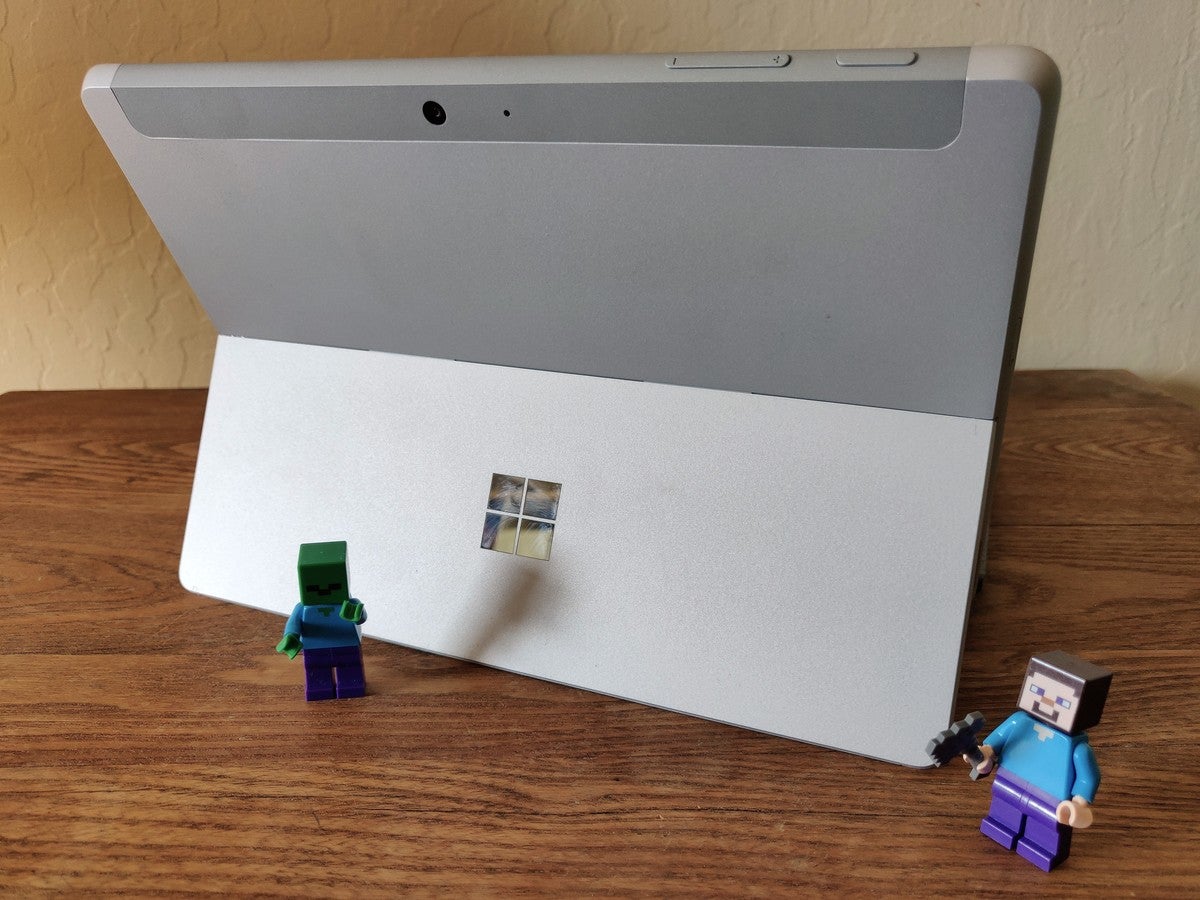 MARK HACHMAN / IDG
MARK HACHMAN / IDGA physical kickstand—still a rarity in the tablet world—folds down from the rear. It can recline to about fifteen degrees off of the horizontal, making it easier for use with a Surface Pen (which we tried—it worked fine) or Surface Dial (which we didn’t). The kickstand gives a bit when in full recline, but the friction hinge keeps the Surface Go 2 steady.
Pogo pins secure the tablet to the keyboard. But the secondary hinge that angles the keyboard up just weakly holds it in place. And, of course, the kickstand is narrow enough to dig into your thighs. Just typing with the Surface Go 2 perched on my lap in a fixed office chair was not especially sturdy or pleasant.
advertisement
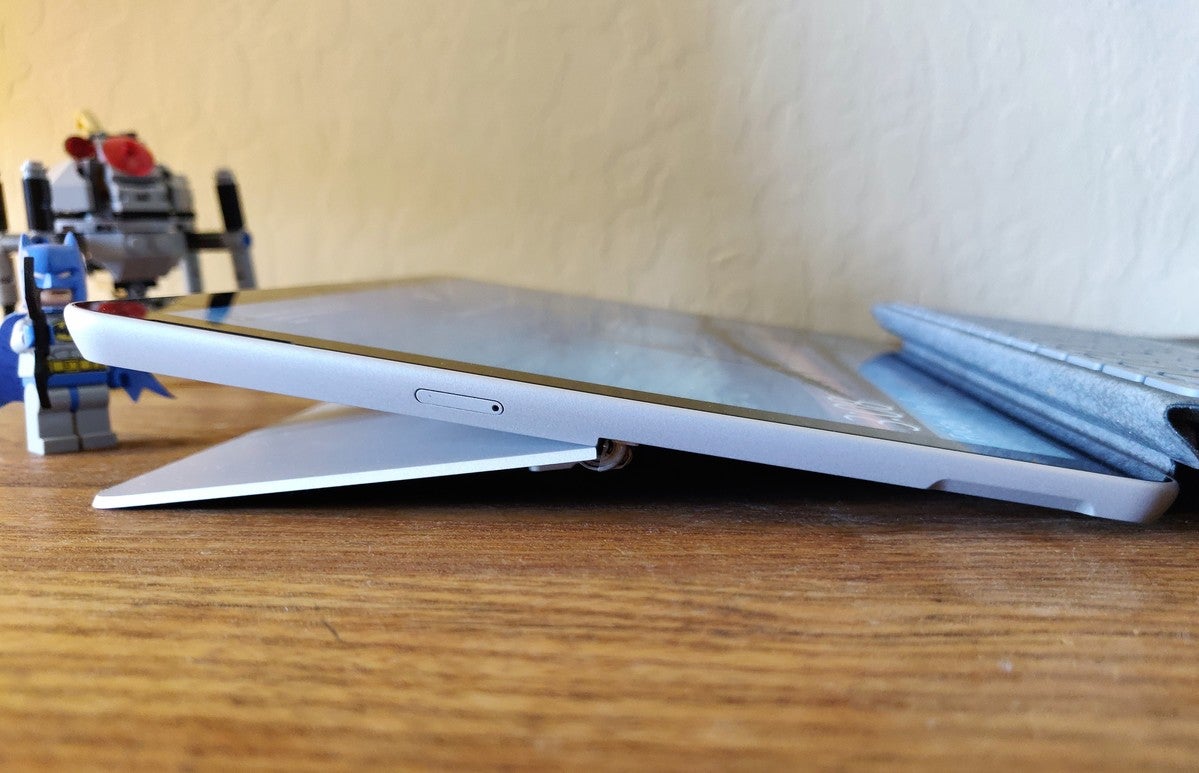 MARK HACHMAN / IDG
MARK HACHMAN / IDGThe Surface Go 2 can power its own screen, one 4K display, and a 1080p display, all at 60Hz, through the first-generation Surface Dock. The Dock didn’t always connect to both displays (even after updating its firmware), but it’s been flaky occasionally with other Surfaces.
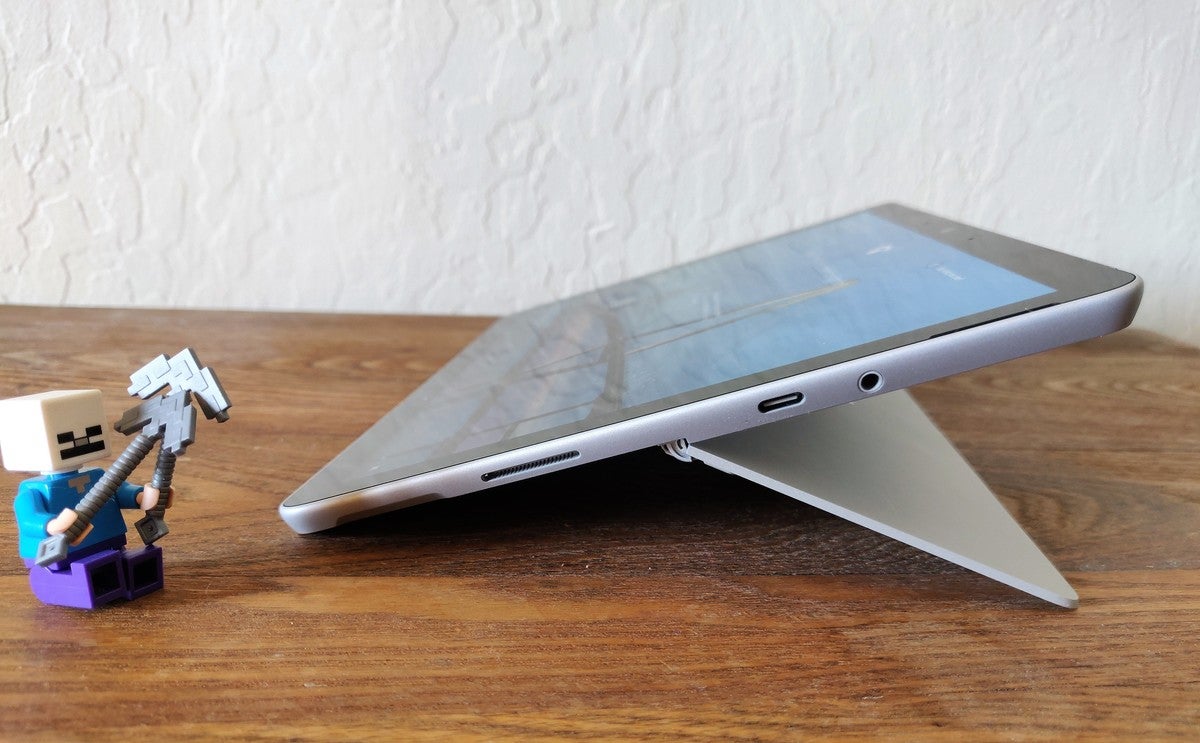 MARK HACHMAN / IDG
MARK HACHMAN / IDGDon’t forget about the microSD (technically, a microSDXC slot) underneath the kickstand. Many USB-C hubs already have that slot, but Microsoft’s own USB-C Travel Hub does not.
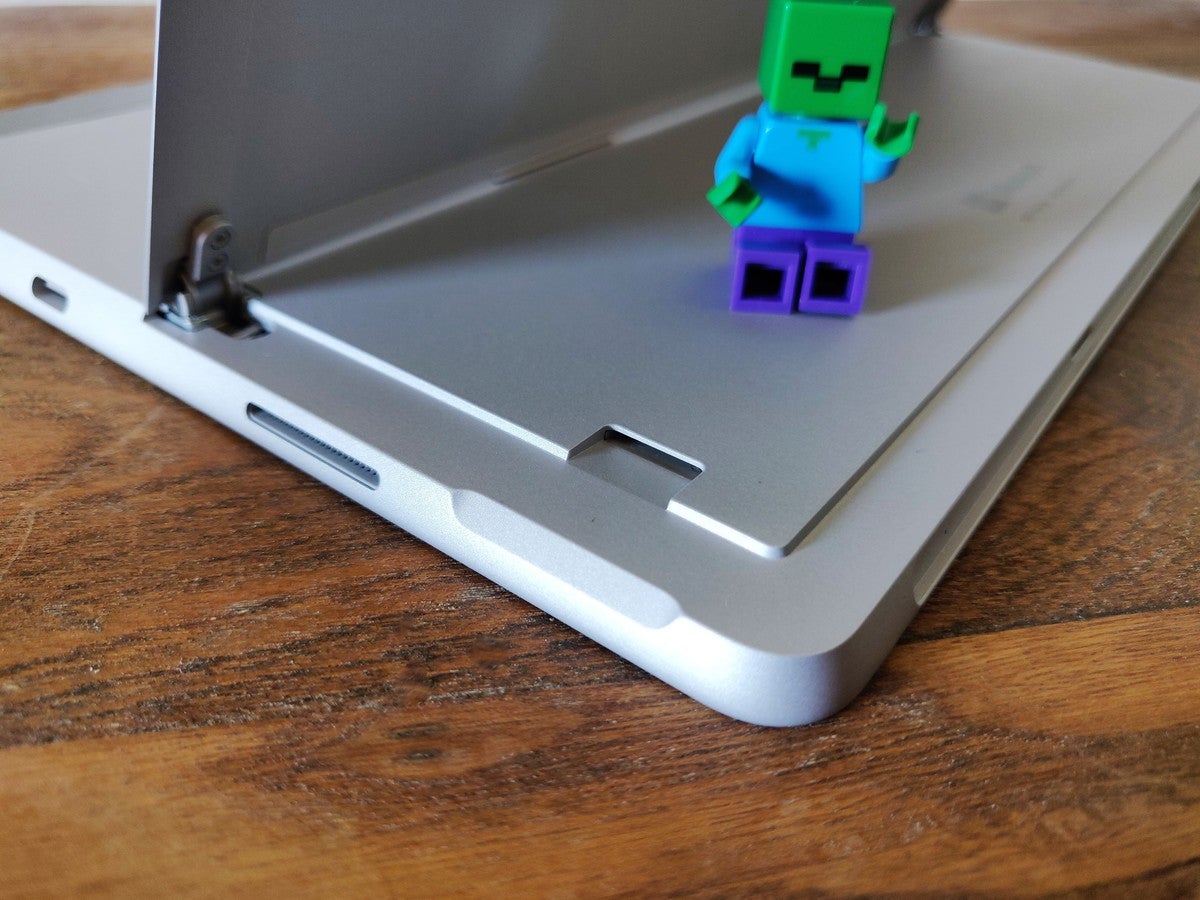 MARK HACHMAN / IDG
MARK HACHMAN / IDGThe Surface Go 2’s dual 2W speakers aren’t especially loud, but tonally they’re pretty accurate. Low-end bass is lacking, as you might expect. Dolby Audio is listed as part of the device’s specifications, but I couldn’t find either Dolby or Realtek audio controls on the tablet, nor in the Store.
Surface Go 2’s webcam: A definite selling point
The Surface devices offer the best integrated, user-facing cameras I’ve ever used, period. The 5MP user-facing camera fits neatly within the top bezel, and it captures 1080p video without a hitch. Its HDR capabilities are good, too. A pair of far-field mics capture your voice well without the need for a headset.
 MARK HACHMAN / IDG
MARK HACHMAN / IDGThe 8MP rear camera may not surpass your smartphone’s, but it’s still rather good. (The image flickered occasionally, but our inquiry about that to Microsoft has yet to receive a response.) It’s primarily there to capture the contents of documents and whiteboards using the integrated Office Lens function, which recognizes and auto-orients the content into something like a traditional Office document for easy sharing.
The Camera app’s “pro mode” hides the ability to swap between 6MP (16:9) or 8MP(4:3) photos, implement digital video stabilization, or zoom manually. There’s no HDR.
Surface Go 2 typing experience: Still unpleasant
The Surface Go’s compact form factor simply doesn’t leave room for a spacious keyboard, and the Surface Go 2 is no different. The keyboard measures 9.4 inches across from key to key, versus 10.75 inches for the Surface Pro 7. That’s almost two keys’ worth of difference.
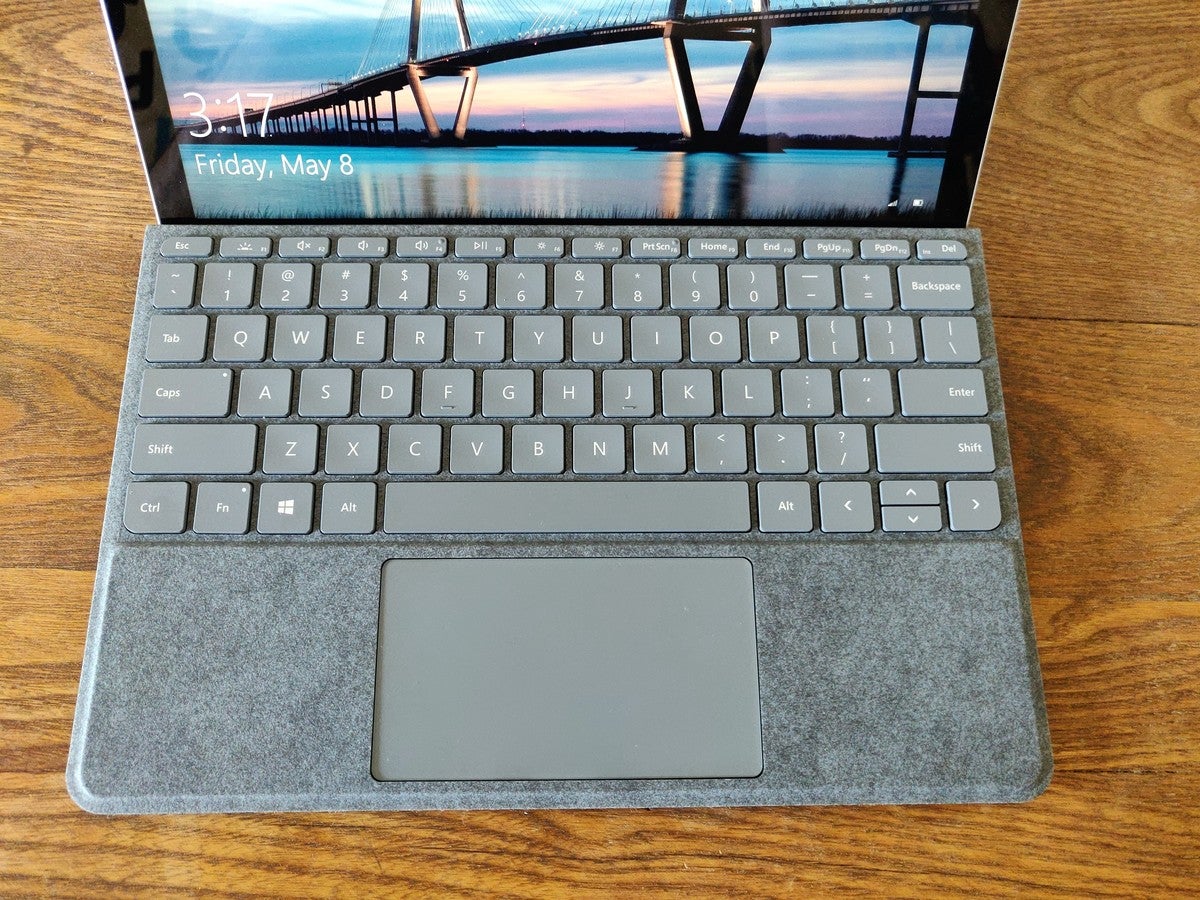 MARK HACHMAN / IDG
MARK HACHMAN / IDGMy opinion of the Surface Go Type Cover hasn’t changed. Microsoft has engineered the keys to be supportive and firm, optimizing the short 1mm travel distance. To be fair, my fingers adjusted to the narrow keys, and my accuracy didn’t suffer greatly. Still, the keys are a bit stiff, and are spaced too close together to be comfortable over longer periods. Perhaps slipping in two new mouse-and-keyboard combos at the tail end of its Surface launch was a deliberate move?
Our Surface Go Signature Type Cover was coated with Alcantara fabric (the Black version is microfiber). The Type Cover still features three levels of backlighting.
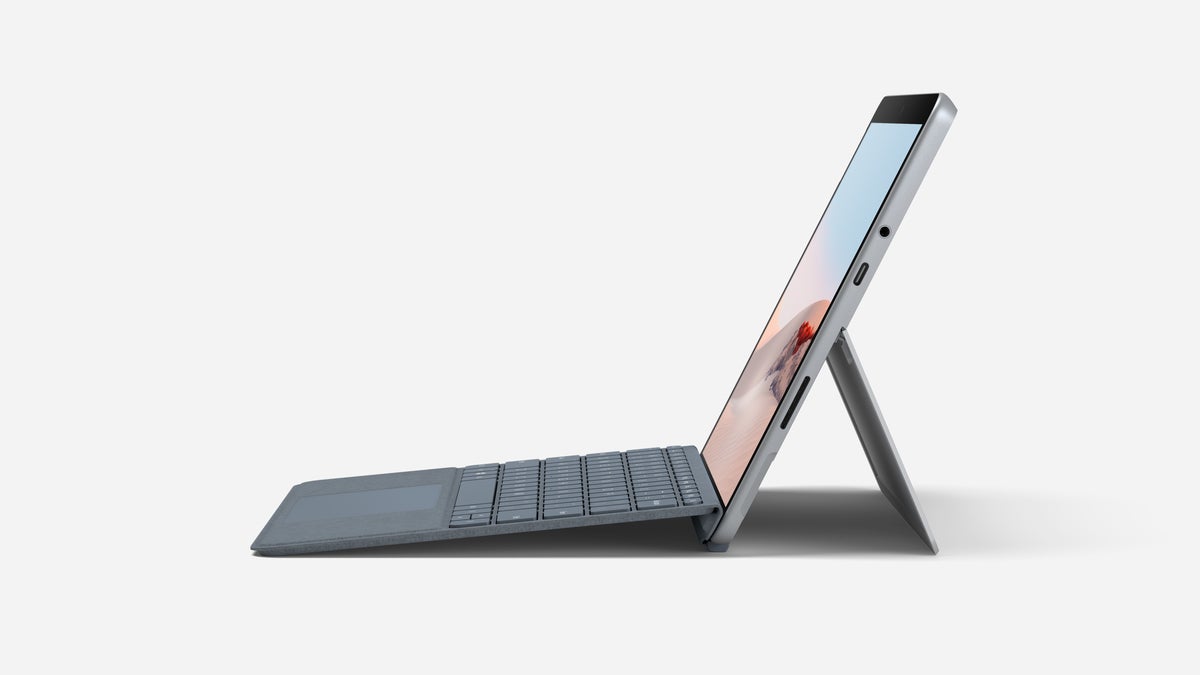 MICROSOFT
MICROSOFTThe Surface Go’s Precision touchpad is average, smooth and tappable across the full range of the sensor. Its clickiness stopped at about the top third of the touchpad.
Surface Go 2’s LTE performance
Our review unit included the LTE option, which you can turn on either by inserting your own microSIM into the side-mounted slot, or else enabling the eSIM functionality included in the machine.
 MARK HACHMAN / IDG
MARK HACHMAN / IDGFor testing, I used a physical T-Mobile SIM and drove around the city, trying out the connection at various points on both the Surface Go 2 and my smartphone. Both my phone and the Surface Go 2 achieved similar results using Bing’s speed test. However, my Surface Go 2 unit appeared to have trouble holding a sustained connection, or at least buffering enough data to stream a 1080p video continuously over YouTube. (The streams were manually set to 1080p, as the default setting was a lower resolution.)
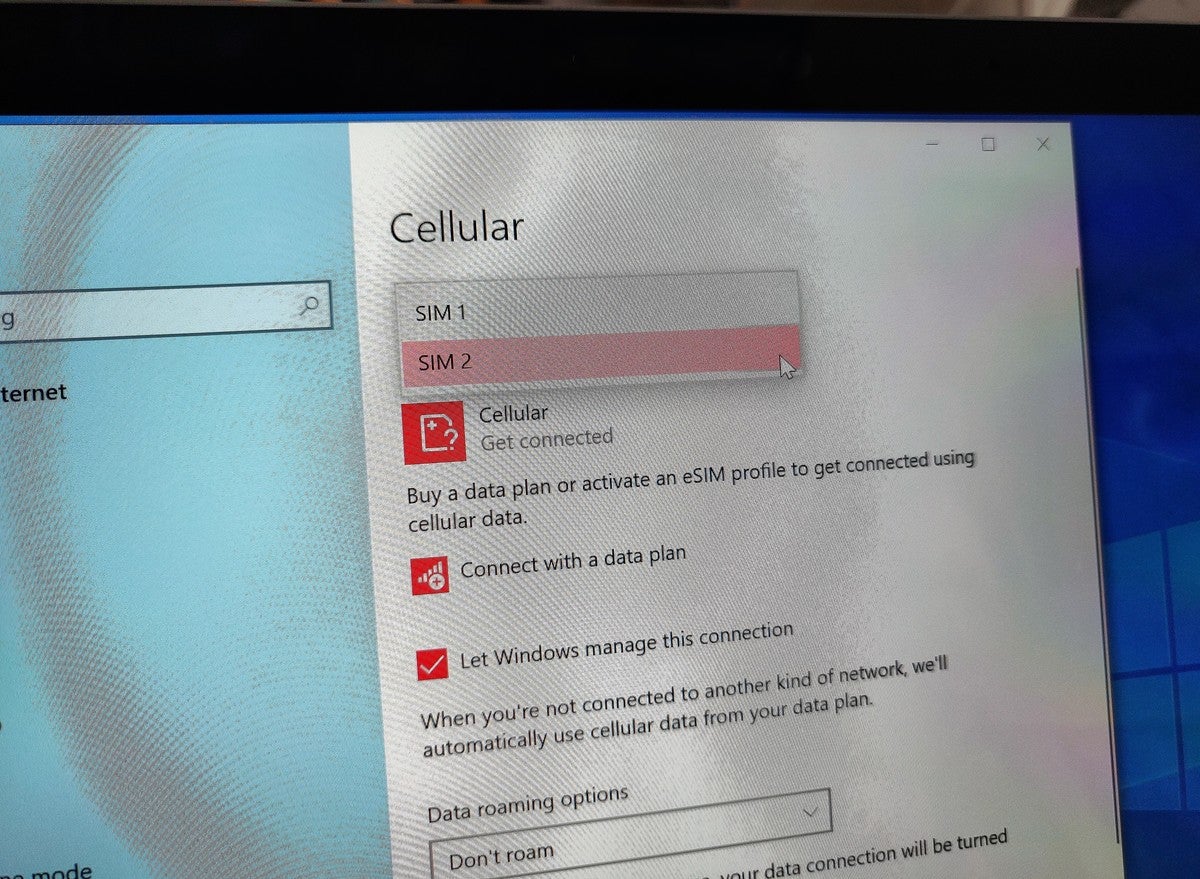 MARK HACHMAN / IDG
MARK HACHMAN / IDGThis behavior continued at multiple locations. (I was unable to double-check this against other LTE-equipped laptops because my carrier, T-Mobile, wouldn’t authorize the connection for some reason.) We notified Microsoft of this issue, and have not yet received a response.
Keep reading for performance, battery life and more.
Surface Go 2: That S Mode…
The Surface Go 2’s default operating system of Windows 10 in S Mode isn’t doing you any favors. Windows 10 S restricts you to using apps from the Microsoft Store, a somewhat meager supply compared to the rich app ecosystems on iOS and Android.
Fortunately, it’s now incredibly, incredibly simple to swap from Windows 10 in S Mode to Windows 10 Home, though it’s a one-way street. All you’ll need to do is visit the Windows 10 Settings menu, click the appropriate link to take you to the Windows Store, and then click the option to switch out of Windows 10 S. The process takes a moment, and it doesn’t even require a reboot. Beautiful!
Surface Go 2: Performance
Given the energy-efficient Y-class processor in our Surface Go 2 unit, you shouldn’t expect much of its performance. Our benchmarks bear that out, as it posted middling to lower scores on most tests.
We include results for the original Surface Go we tested. Because it has a Pentium chip, it gives some indication of how the Pentium-based Surface Go 2 would perform if we tested it.
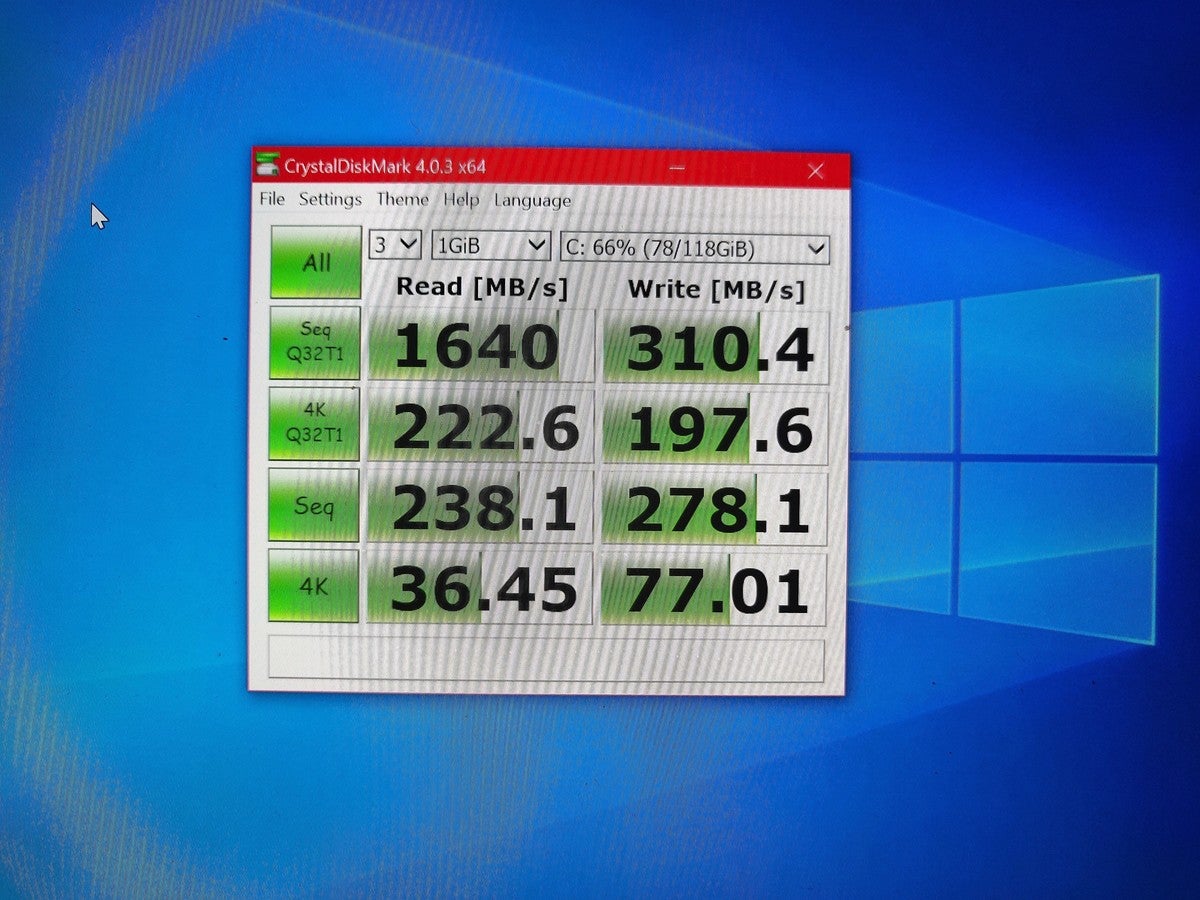 MARK HACHMAN / IDG
MARK HACHMAN / IDGThough we expect the majority of users will convert the Surface Go 2 from Windows 10 Home in S Mode to Windows 10 Home, we tested the Surface Go 2 (red bars below) in S Mode first, against older cross-platform hardware. This allowed us to include the results for the original Surface Go (orange bars below), which finished near the bottom against a pile of devices including Apple Macs, PCs, tablets, and so on. These older benchmarks are from our database, but we re-ran the Surface Go and Go 2 numbers for a more direct comparison, and also used the new Microsoft Edge browser.
Both of Principled Technologies’ WebXPRT tests are designed to mimic “real-world,” web-based HTML5 and JavaScript tasks like photo enhancement, online homework, and stock option pricing. The WebXPRT 3 test is the more recent (see shorter bars below), though we have more results with the 2015 test (see longer bars below). The Surface Go 2 does well here, landing in the upper middle of the rankings.
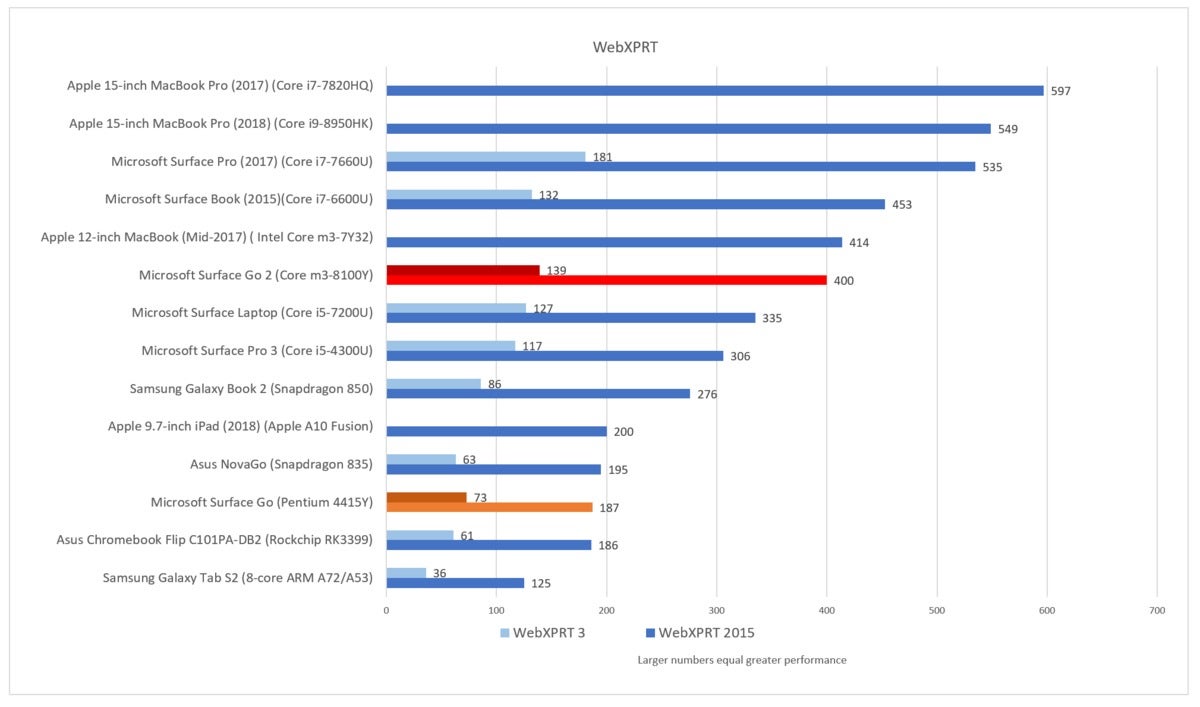 MARK HACHMAN / IDG
MARK HACHMAN / IDGWe see a milder improvement in the JetStream 1.1 benchmark, which covers JavaScript performance over a variety of advanced workloads and programming techniques. The Surface Go 2 leads the back of the pack, with a significant lead over our first-gen Surface Go unit.
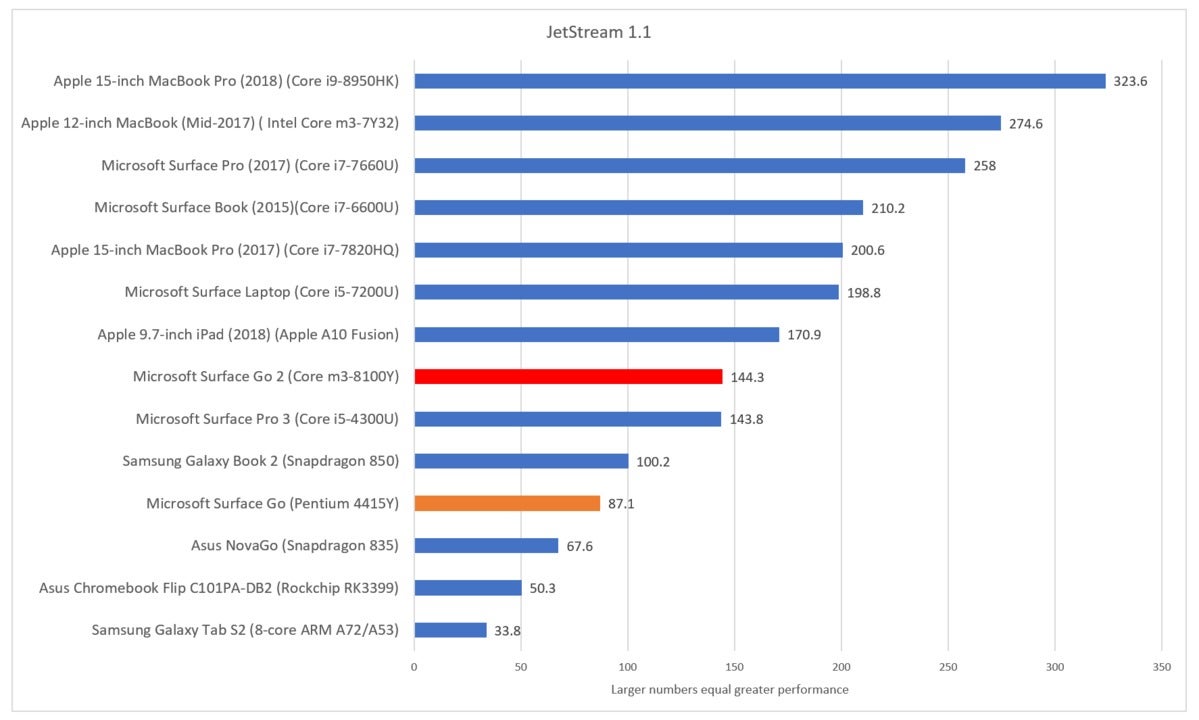 MARK HACHMAN / IDG
MARK HACHMAN / IDGSpeedometer is another longstanding web benchmark. We show results both for version 1.0 (lighter bar) and version 2.0 (darker bar). In both cases, the Surface Go 2 scores at or near the top, an impressive feat.
 MARK HACHMAN / IDG
MARK HACHMAN / IDGThe Surface Go 2 falls back to earth in the Octane 2.0 broad-based web test, landing squarely in the middle of the pack.
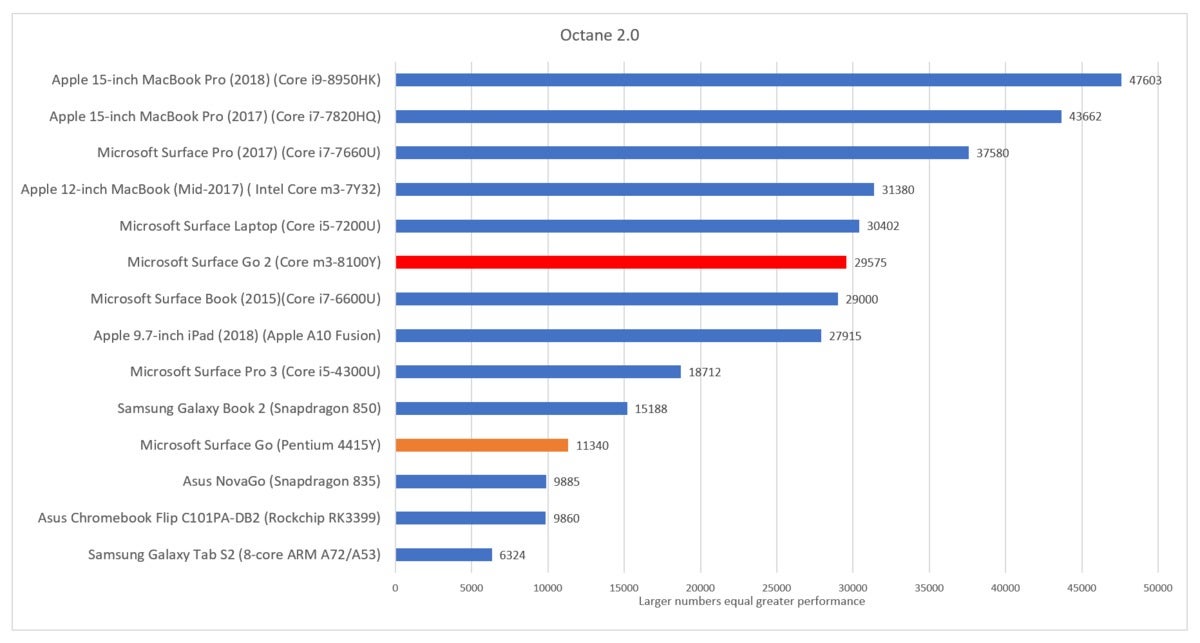 MARK HACHMAN / IDG
MARK HACHMAN / IDGAfter upgrading to Windows 10 Home, we were able to use pseudo-real-world test suites like the PCMark 8 and PCMark 10. Both tests tend to also run on Qualcomm Snapdragon machines, another option in the tablet space. We were also able to add laptops in the same price range as the Surface Go 2: the Walmart Motile M142 and Acer Aspire 5, both traditional laptops, and the latest $650 Ryzen Mobile 4000-powered Swift 3, a clamshell PC that delivers insane performance for less money than the Surface Go 2.
For PCMark 8 we ran the Work and Creative tests, which mimic the way in which (older) PCs run, testing spreadsheet work, video call performance, light gaming, and more. The Surface Go 2 lands in the middle.
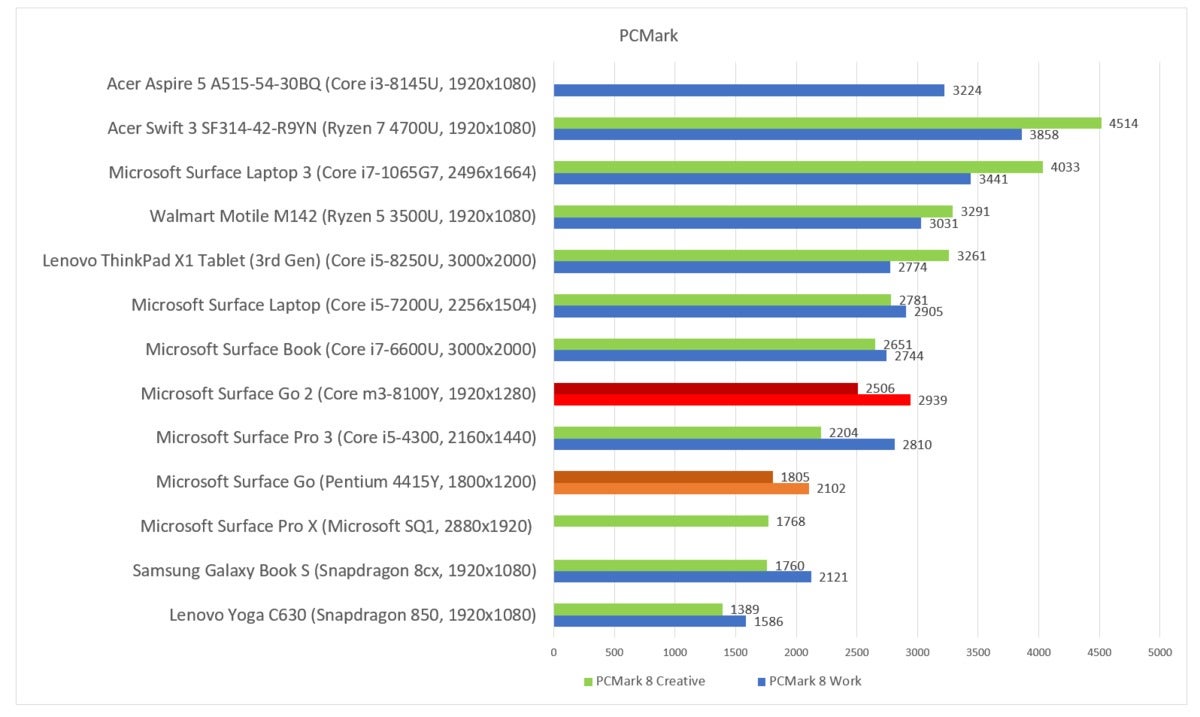 MARK HACHMAN / IDG
MARK HACHMAN / IDGPCMark 10’s Apps benchmark (blue bars above) goes further by actually interacting with Microsoft Edge, Word, Excel, and PowerPoint, testing app startup, and how well the machine handles large spreadsheets and surfs the web. It’s a real-world test that puts significant emphasis on startup times and general responsiveness. The Surface Go 2 did well here, too.
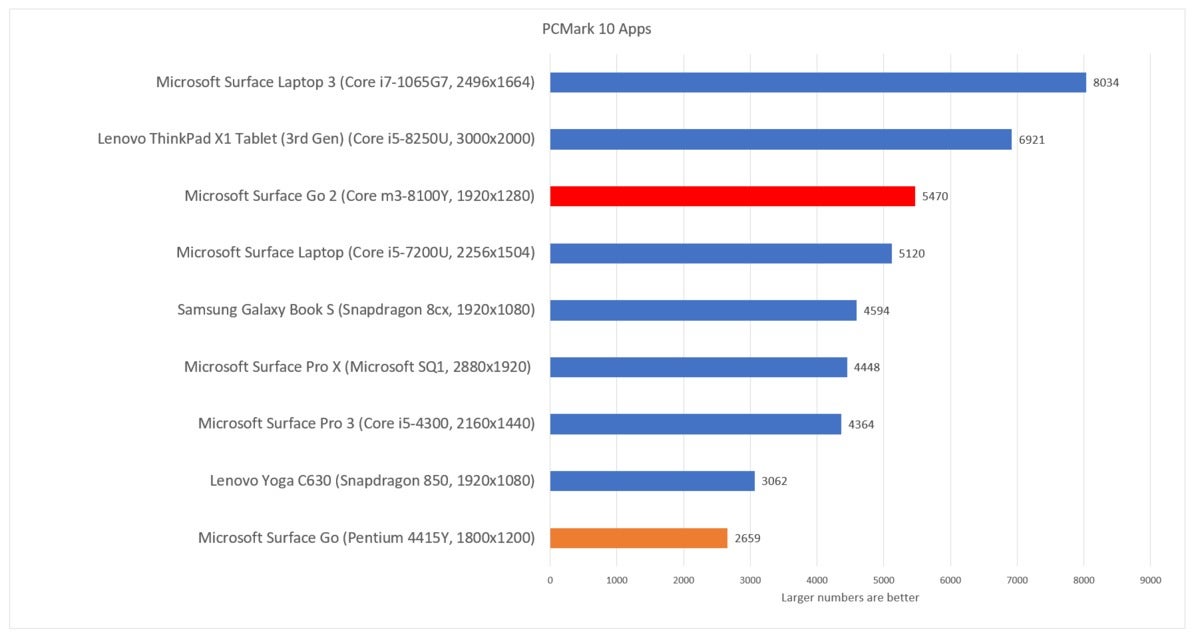 MARK HACHMAN / IDG
MARK HACHMAN / IDGBy now, you’re probably familiar with Cinebench, Maxon’s CPU stress test. The dual-core Core m will never keep up with its quad-core rivals, but it keeps well ahead of the Pentium-based Surface Go.
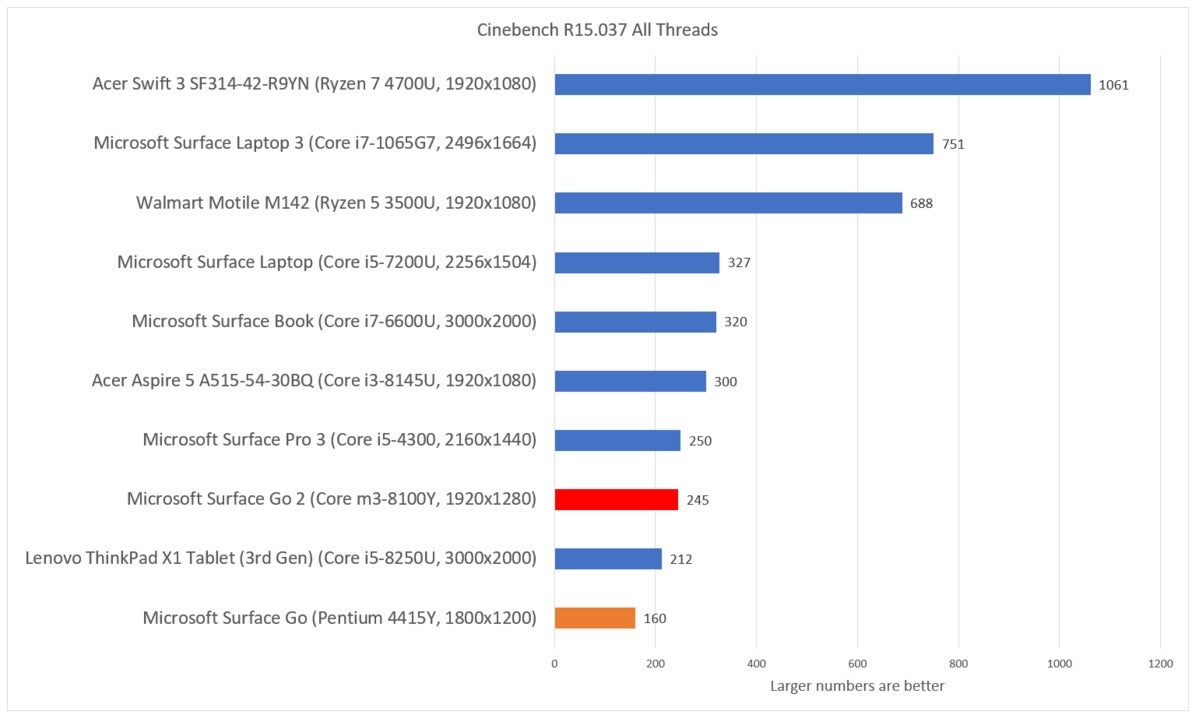 MARK HACHMAN / IDG
MARK HACHMAN / IDGHandBrake is a video conversion tool that transcodes a feature-length movie into a format suitable for a tablet. As a fanless device, the only way for the Surface Go 2 to keep up is to throttle down or try to passively vent as much heat as it can. It struggles.
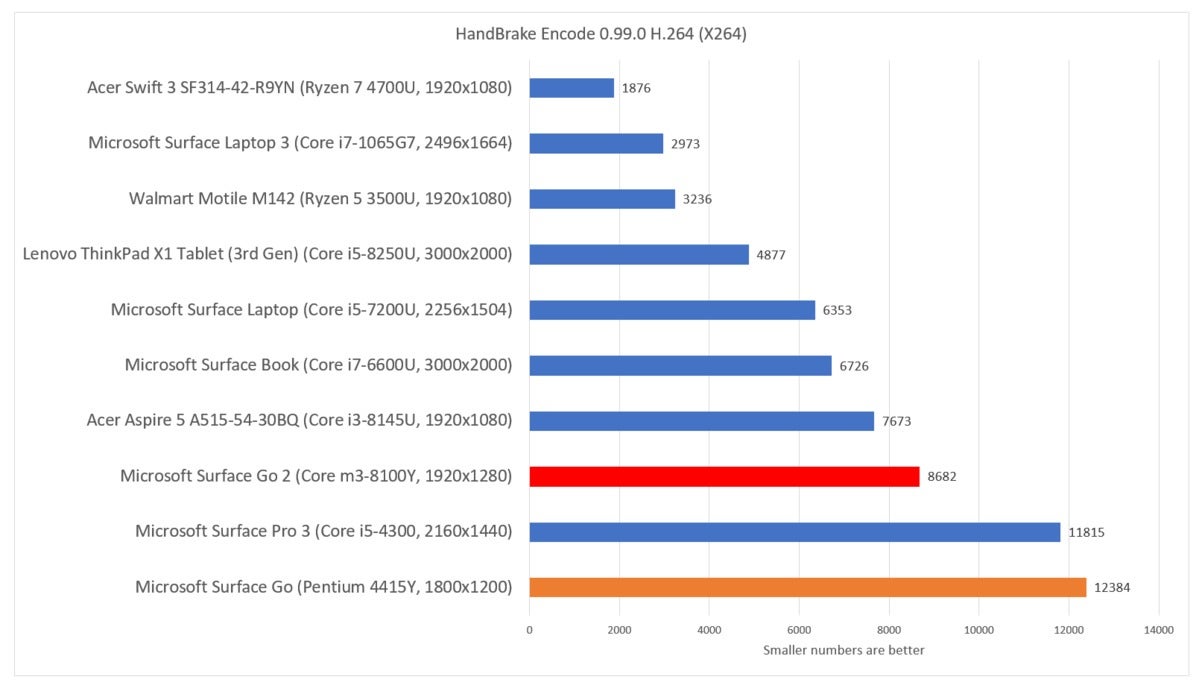 MARK HACHMAN / IDG
MARK HACHMAN / IDGIn graphics, we turn to a cross-platform benchmark, 3DMark’s Night Raid test. It’s the only graphics benchmark that manages to run on both Core and Qualcomm Snapdragon platforms, so we can compare a breadth of offerings. The Surface Go 2 labors in the lower middle of the results.
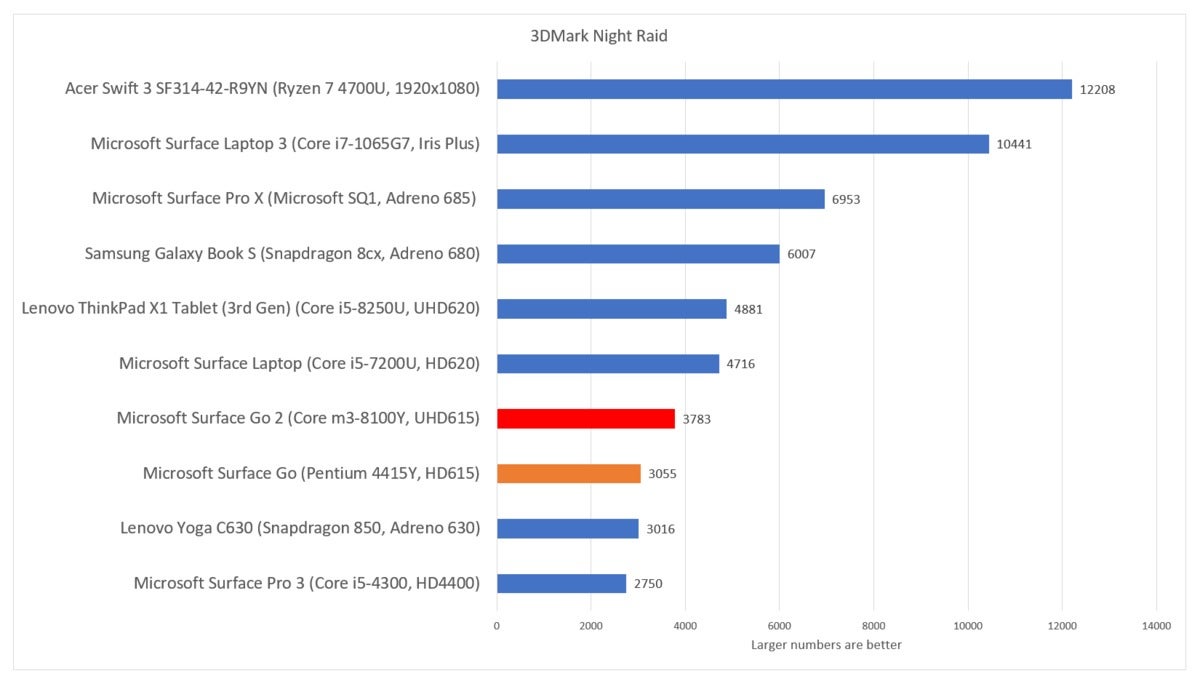 MARK HACHMAN / IDG
MARK HACHMAN / IDGWhile the Surface Go 2’s benchmarks are mostly average, the biggest limitation I found in real-world usage was the small primary display, which made viewing spreadsheets or loading dozens of browser tabs unwieldy. After hooking up an external monitor, I was able to do most of my work without a hitch. The Surface Go 2 does noticeably drop frames when playing back 4K/60 video, at higher bitrates than most use, but it handles 1080p and 1440p video just fine. We wouldn’t recommend the Go 2 for gaming or graphics-intensive rendering, though image manipulation is within its grasp.
Finally, there’s battery life. The Surface Go 2 is relatively tiny, and the battery is too: 26.8Wh, versus 26.1Wh in the first-generation Surface Go. With a slightly more efficient chip and a bit larger display, we expected a wash with the original Surface Go. That’s about right. About 7 hours and 20 minutes of batter is acceptable.
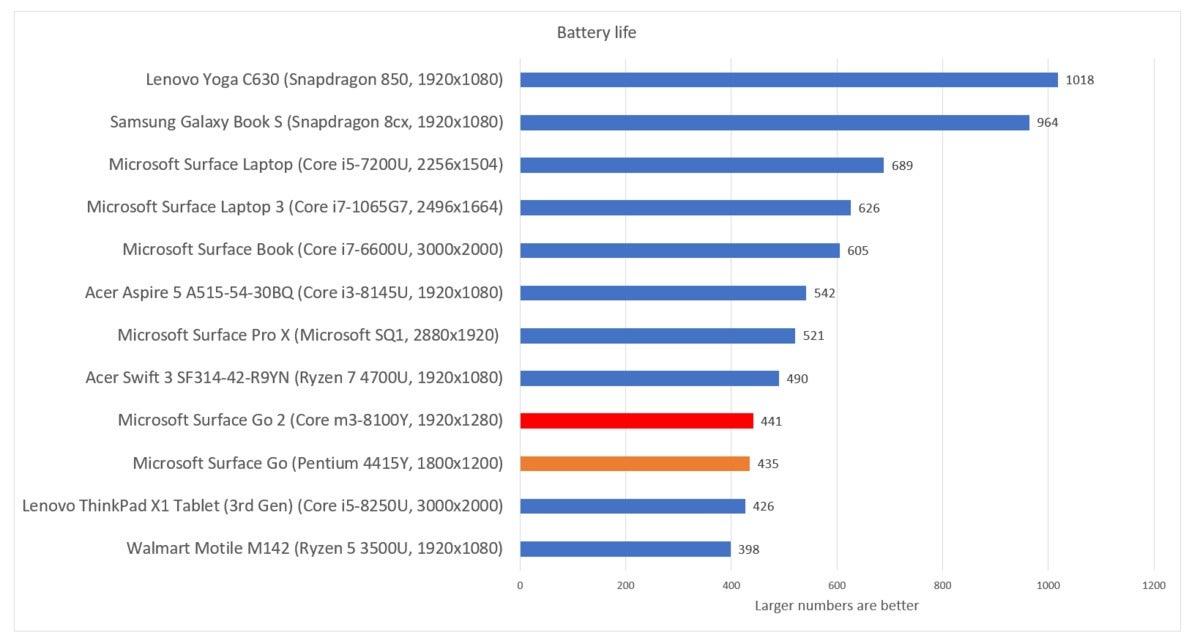 MARK HACHMAN / IDG
MARK HACHMAN / IDGConclusion: Should you buy the Surface Go 2?
The Surface Go 2 debuts at an uncertain time. When everyone is sheltering in place, an ultramobile tablet for travelers isn’t especially valuable. On the other hand, students attending classes online could use a relatively low-cost Surface that’s optimized for videoconferencing as well as everyday web and office work.
But the Surface Go 2 is pricey. For $170 more than our review unit, you can buy a 8GB RAM/128GB SSD version of the Surface Pro 7, with a bigger screen and keyboard and a more powerful processor, though without LTE.
Our rating reflects how we feel about the Microsoft Surface Go 2. We give it polite applause for its design and features, with reservations about its performance and especially its price. You won’t be unhappy when you buy it, but you probably won’t be thrilled either. That’s the difference between a good product and a great one.